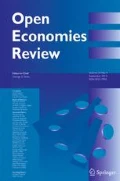Abstract
Following the well-known approach by Adler and Dumas (Financ Manage 13(2):41–50, 1984), we evaluate the foreign exchange rate exposure of nations. Results based on data from 27 countries show that national foreign exchange rate exposures are significantly related to the current account and financial account balance variables of corresponding economies.



Similar content being viewed by others
Notes
Commonly, the yield of the world index depends on the price of the special drawing right. To capture the aggregate risk of the yield of the world index not induced by exchange rate fluctuations we orthogonalized the yield of the world index. This so-called residual market factor \(R_{W}^{\circ}\) (McElroy and Burmeister 1988) is represented by the residual of an auxiliary regression model in which the original R W is regressed on the price of the special drawing right. Thus, \(R_{W}^{\circ}\) and sdr i are uncorrelated.
Turkey was not considered due to data problems.
MSCI offers two kind of performance indices: the Gross Index and the Net Index. While the latter “approximates the minimum possible dividend reinvestment” with respect to tax regulations, the former “approximates the maximum possible dividend reinvestment”. For exact definitions see MSCI Index Calculation Methodology (2005).
See www.imf.org for further details.
See Triennial Central Bank Survey (2005).
Except Luxembourg, which is not part of our data set.
Ordinary least squares estimators differ only slightly from system estimators. The sign of the estimator changed only for Hungary and Italy. However, both coefficients are far from being significant in both estimation procedures.
Notice in the SUR the value of the coefficient changes if the orthogonalized world index is excluded, while in the OLS regression both covariates are made independent and, therefore, the exposure coefficient is the same.
This figure is confirmed by the CIA worldfactbook which reports a ratio of 1.45 for 2004.
Performing the same regression by using foreign exchange rate exposure coefficients of single equation estimation both coefficients are very similar in magnitude and significance as well as R 2 increased.
This method is also called leave-one-out estimation, cf. Diebold (2001).
Of course, countries like Spain are not considered as an Emerging market from today’s perspective.
For some countries the error and omission account is larger than 10% of the size of the balance sheet total.
ρ(CB,FADI) = − 0.51, ρ(CB,FAPI) = − 0.59 and ρ(CB,FAOI) = − 0.18.
Results are not presented. They will be available from the authors upon request.
To further examine the influence of the euro, the sample was also restricted to pre-euro years from January 1991 to December 1998. The results can be obtained from the authors upon request.
References
Adler M, Dumas B (1984) Exposure to currency risk: definition and measurement. Financ Manage 13(2):41–50
Allayannis GS, Ofek E (2001) Exchange rate exposure, hedging and the use of foreign currency derivatives. J Int Money Financ 20(2):273–296
Bartram SM, Karoly GA (2006) The impact of the introduction of the euro on foreign exchange rate risk exposures. J Empir Finance 13:519–549
Bernanke BS (2005) The global saving glut and the U.S. current account deficit, Sandridge lecture. Virginia Association of Economists, Richmond
Bodnar GM, Gentry W (1993) Exchange rate exposure and industry characteristics: evidence from Canada, Japan and the USA. J Int Money Financ 12(1):29–45
Diebold FX (2001) Elements of forecasting, 2nd edn. Southwestern College, Cincinnati
Dominguez K, Tesar L (2001) A re-examination of exchange rate exposure. Am Econ Rev - Pap Proc 91:2396–2399
Dominguez K, Tesar L (2006) Exchange rate exposure. J Int Econ 68(1):188–218
Entorf H, Jamin G (2007) German exchange rate exposure at DAX and aggregate level, international trade, and the role of exchange rate adjustment costs. Ger Econ Rev 8(3):344–374
He J, Ng LK (1998) The foreign exchange exposure of Japanese multinational corporations. J Finance 53(2):733–753
International Monetary Fund (2005) Review of the method of valuation of the SDR. Finance Department, approved by Michael G. Kuhn, October 28, 2005
Jorion P (1990) The exchange-rate exposure of U.S. multinationals. J Bus 63(3):331–345
Koutmos G, Martin AD (2003) Asymmetric exchange rate exposure: theory and evidence. J Int Money Financ 22(3):365–383
Morgan Stanley Capital International (2005) Index calculation methodology. Morgan Stanley Capital International, New York
McElroy MB, Burmeister E (1988) Arbitrage pricing theory as a restricted nonlinear multivariate regression model. J Bus Econ Stat 6(1):29–42
Rees W, Unni S (2005) Exchange rate exposure among European firms: evidence from France, Germany and the UK. Account Finance 45(3):479–497
Triennial Central Bank Survey (2005) Foreign exchange and derivarives market activities in 2004. Bank for International Settlements, Basel
Acknowledgements
We are grateful to Thorsten Cors from Morgan Stanley Capital International Inc. for information on the MSCI indices methodology. We also thank two anonymous referees and Birgit Herrmann for helpful comments and suggestions.
Author information
Authors and Affiliations
Corresponding author
Rights and permissions
About this article
Cite this article
Entorf, H., Moebert, J. & Sonderhof, K. The Foreign Exchange Rate Exposure of Nations. Open Econ Rev 22, 339–353 (2011). https://doi.org/10.1007/s11079-009-9128-6
Published:
Issue Date:
DOI: https://doi.org/10.1007/s11079-009-9128-6




